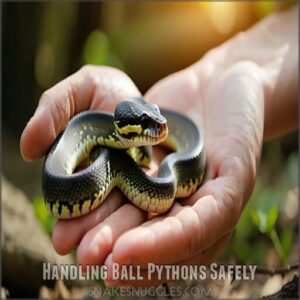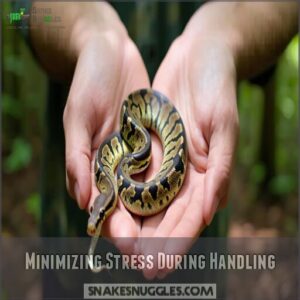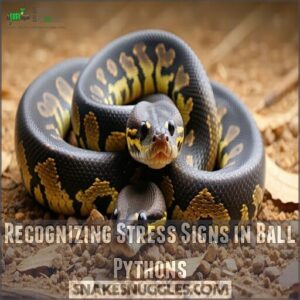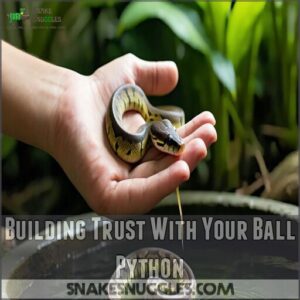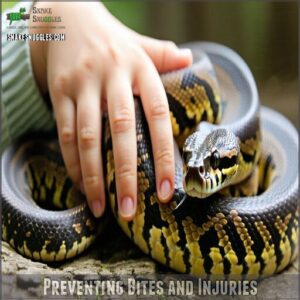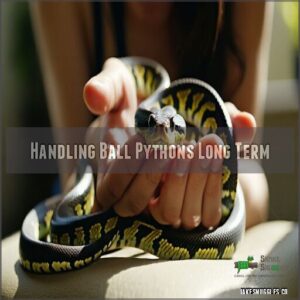This site is supported by our readers. We may earn a commission, at no cost to you, if you purchase through links.
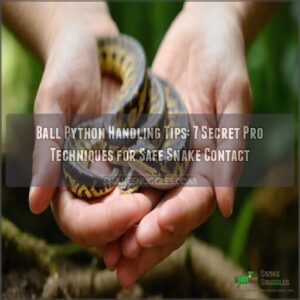
Don’t grab them after meals or during shedding—they’re like us after Thanksgiving dinner, just wanting to be left alone.
Keep sessions short (5-15 minutes) and watch for stress signals like hissing or ball-forming.
Move slowly and confidently, as jerky movements can spook even the most docile snake.
Never pick them up from above—that’s predator behavior in snake language.
Always lift gently from the middle of their body.
The right handling technique can transform a nervous noodle into a confident companion.
Table Of Contents
- Key Takeaways
- Handling Ball Pythons Safely
- Choosing Handling Time
- Safe Handling Techniques
- Managing Stress and Fear
- Handling Ball Pythons Long Term
- Frequently Asked Questions (FAQs)
- How do ball pythons like to be handled?
- How to tell if a ball python is comfortable with you?
- Do ball pythons like to be cuddled?
- What is a ball python Care Guide?
- How to handle a ball python?
- Should you wash your hands before handling a ball python?
- Can a ball python be handled too much?
- How often should you handle ball python?
- How to bond with a ball python?
- Are ball pythons easy to handle?
- Conclusion
Key Takeaways
- You’ll need to support your ball python’s entire body with both hands, using a gentle grip that allows natural movement while keeping them secure.
- Always wash your hands before handling to remove food scents that could trigger a feeding response, and wait 24-48 hours after meals before handling to prevent regurgitation.
- Watch for stress signals like hissing, defensive S-shaped posture, or tight ball formation, and keep initial sessions short (5-15 minutes) to build trust gradually.
- Approach your snake calmly and from the side rather than above, as sudden movements or approaching from above mimics predator behavior and can cause unnecessary stress.
Handling Ball Pythons Safely
You’ll need to support your ball python’s body with both hands while maintaining a gentle grip that allows natural movement.
Washing your hands before handling isn’t just good hygiene—it prevents your fingers from smelling like that tasty mouse dinner your snake might mistake them for, which is a matter of good hygiene and also prevents a potential mistake due to natural movement.
Importance of Cleanliness
Your snake’s safety starts with clean hands. Always wash thoroughly before handling to reduce bacteria and prevent parasites like salmonella.
Scent your hands with sanitizer to make them smell inedible to your ball python. Their powerful sense of smell means chemical scents can trigger feeding responses or stress.
After handling, wash again to maintain good snake hygiene. Never handle with food-scented hands, and always supervise children during snake interaction.
To maintain a healthy habitat, consider using reptile habitat cleaner.
Pre-Handling Checklist
A thorough pre-handling checklist guarantees your ball python encounter goes smoothly.
Before reaching for your serpentine friend, run through these essential steps:
- Wash hands thoroughly to remove food scents and bacteria
- Check your snake’s feeding schedule (wait 24-48 hours after meals)
- Look for signs of stress or defensive posture
- Remove jewelry that could snag scales
- Confirm the handling area is secure with no escape routes
Always prioritize safe handling practices to avoid stress for both you and your snake, ensuring a pleasant experience for all parties involved.
Avoiding Handling During Shedding
Now that your hands are clean, watch for signs of shedding before picking up your ball python.
During the shed cycle, your snake’s eyes turn blue and opaque scales appear, indicating impaired vision.
This makes them jumpy and prone to defensive bites.
Skip handling until shedding completes and maintain 70-75% humidity to help them along.
A grumpy snake during shedding isn’t being difficult—they’re just uncomfortable!
Avoiding Handling After Feeding
While your ball python is in shed mode with cloudy blue eyes, it’s time to give them space.
After feeding, similar patience is required, wait at least 24-48 hours before handling your snake post-meal to prevent regurgitation risk and digestion discomfort.
Your ball python needs time to process that mouse, consider this your snake’s "do not disturb" sign.
A proper feeding schedule helps you track when handling is safe again.
Choosing Handling Time
You’ll need to pick the right moment for handling your ball python, as timing can mean the difference between a successful interaction and a stressed snake.
Just like you wouldn’t want someone waking you up mid-nap, your slithery friend needs their schedule respected, especially avoiding handling right after meals or during the challenging shedding process.
Handling Frequency
When establishing a ball python handling routine, finding the right frequency is vital for both you and your snake.
Here’s what experts recommend:
- Aim for weekly handling (1-2 sessions) to maintain trust
- Never exceed once daily to prevent stress and overhandling risks
- Establish a consistent schedule your snake can adapt to
- Wait until your new snake eats regularly before starting regular handling
The key to a successful handling routine is to balance interaction with your snake’s need for solitude, ensuring that both you and your pet benefit from the experience.
Recognizing Signs of Stress
During handling sessions, watch for these key stress indicators in your ball python: erratic movements, restlessness, excessive daytime activity, and continuous roaming.
Your snake may also display Defensive Postures like hissing, deep Breathing Changes, or striking.
A Curled Posture (staying balled up), Refusal Movement, or Hiding Behavior when approached are clear signs to postpone handling.
Observing your snake’s behavior can also tell you if it’s healthy, so look for clear and bright eyes.
Learning these snake stress signals helps you avoid stress and build trust.
Avoiding Sudden Movements
When approaching your ball python, sudden movements can trigger a startle response and cause unnecessary stress.
Always use slow, predictable movements to help your snake feel secure during handling sessions. Consistent handling helps build trust and prevents defensive behaviors, but bear in mind handling frequency guidelines.
- Maintain a calm demeanor by breathing steadily before reaching for your snake
- Use gentle guidance rather than quick repositioning when directing your python
- Move your hands at a consistent, unhurried pace to build trust
Safe Handling Techniques
You’ll build confidence and trust with your ball python by using proper handling techniques that support their entire body while keeping both of you safe.
When you approach your scaly friend gently from the side rather than above and use two hands to provide full support, you’ll create a stress-free experience that makes handling enjoyable for everyone involved.
Approaching The Snake Calmly
The secret to successful ball python handling starts with a calm approach.
Always move slowly and deliberately when opening their enclosure.
Your snake views sudden movements as threats, so take your time.
Gentle handling builds trust, while avoiding startling your pet builds confidence.
Remember to approach from behind rather than above—this respects your ball python’s perspective and reduces defensive reactions, promoting a gentle handling environment that is essential for building trust.
Supporting The Snake’s Body
The key to proper ball python handling lies in supporting the snake’s body correctly.
Always use two hands with a loose but secure grip—one supporting the middle and another near the front section.
This technique prevents spinal injury while allowing free movement.
Think of it like holding a delicate rope bridge—firm enough for security, gentle enough to avoid stress or harm, and to ensure the snake’s body is handled with the right amount of care to prevent any potential harm.
Handling The Snake’s Head
While you’ve mastered supporting your ball python’s body, the head requires special attention. Most pythons dislike having their heads touched, so avoid gripping behind the head unless absolutely necessary.
- Never squeeze or choke your snake when handling its head
- Use gentle guidance instead of forceful control
- Approach from behind to prevent triggering defensive reactions
- Signal interaction with a light tap using a paper towel roll
- Let your snake move its head freely to maintain trust
If you must direct your python’s head, use your free hand to gently guide it away from unwanted areas rather than restraining it. For added safety, some handlers opt for specialized protective gear.
Minimizing Stress During Handling
Stress-free handling sessions create a foundation of trust between you and your ball python.
Keep initial interactions short—just 5-10 minutes—and gradually increase as your snake becomes comfortable.
Watch for stress signs like rapid breathing or tight coiling. Always use a gentle touch with secure support, and return your python to its enclosure at the first sign of distress.
Your calm approach substantially impacts your snake’s comfort level. Recognizing these signs is vital, as body language matters to ensure a positive handling experience.
Managing Stress and Fear
You’ll quickly notice when your ball python feels stressed, with signs like balling up, rapid breathing, or hiding its head.
Recognizing these cues and responding calmly will help build trust between you and your scaly friend, making handling sessions more enjoyable for both of you, which involves being aware of your pet’s behavior and reacting in a calm manner.
Recognizing Stress Signs in Ball Pythons
During handling sessions, your ball python may display subtle cues that signal stress. Learning to identify these warnings helps prevent defensive reactions and keeps both you and your snake comfortable.
Here are 4 key stress indicators to watch for:
- Defensive postures like the "S" shape or tight ball formation
- Rapid breathing changes or hissing sounds
- Body language shifts including muscle tensing or jerky movements
- Color changes, particularly darkening around the head
Refusal to eat can be a sign, indicating possible psychological stress factors, which may require careful observation to manage defensive reactions and ensure a comfortable environment for your ball python.
Building Trust With Your Ball Python
Trust with your ball python doesn’t form overnight—it develops through patience and consistent interaction.
Building trust with your ball python takes patience, calm handling, and consistent care, creating a bond that lasts a lifetime.
When handling your snake, maintain a calm demeanor and follow these guidelines:
| Trust-Building Action | Frequency | Expected Outcome |
|---|---|---|
| Gentle handling sessions | 1-2 times weekly | Reduced defensive behavior |
| Positive reinforcement | After each handling | Association with positive experiences |
| Gradual introduction to handling | Initially 5-10 minutes | Building confidence in both handler and snake |
Creating a safe environment where your ball python feels secure is essential for establishing long-term trust.
Preventing Bites and Injuries
Now that you’ve built trust with your snake, let’s focus on safety. Ball python bites are rare but can happen if your pet feels threatened or hungry.
Always wash your hands thoroughly (handling hygiene matters!) and never jerk away if bitten – this can damage their teeth.
Recognize aggression signs like elevated breathing or S-shaped posture, and keep the snake’s head away from your face.
Always supervise children during snake handling to make certain everyone stays safe.
Handling Ball Pythons Long Term
You’ll build a stronger bond with your ball python through consistent, gentle handling over the years, just like any long-term relationship needs regular attention.
Maintaining this handling routine both keeps your snake comfortable with human contact and allows you to spot potential health issues early, giving your scaly friend the best chance at a healthy 30+ year lifespan.
Handling Hatchlings and Juveniles
Now that you’re comfortable managing stress signs, let’s focus on your tiniest slithery friends.
Baby ball pythons often react defensively when first handled, making patience required when building trust.
Start with short sessions of just 5-10 minutes, using a gentle approach.
If your hatchling strikes, don’t pull away—this is normal! Gradual introduction to handling helps juveniles become confident companions.
Remember, those defensive strikes will decrease with consistent, calm interaction.
Handling Adult Ball Pythons
Your adult ball python’s temperament generally stabilizes as it matures, making handling more predictable. You’ll need to adjust your grip techniques as they grow larger but remain gentle to maintain trust.
Remember to always wash hands thoroughly before and after handling.
- Use a secure grip with one hand supporting the middle and another near the front third of the body
- Keep handling sessions under 20 minutes to prevent stress
- Watch for subtle signs of discomfort like quick tongue flicks or muscle tensing
Monitoring Ball Python Health
While handling your adult ball python regularly, don’t forget to monitor their health.
Check for clear eyes and intact skin without shedding problems. Watch for respiratory issues like wheezing or bubbling around nostrils.
Maintain proper enclosure hygiene to prevent parasites. Monitor weight management by ensuring a rounded body shape—neither too thin nor overweight.
Be alert to stress signs like constant hiding or regurgitation, which might indicate an infection or improper handling.
To avoid issues such as mouth rot, minimize handling after feeding.
Providing Proper Care and Housing
Your ball python’s home directly impacts its handling temperament.
Maintain 50-60% humidity levels and a proper temperature gradient (75°F cool side, 88-92°F warm side) to keep your snake comfortable and less defensive.
Choose the right substrate like cypress mulch or coconut husk for humidity control.
A proper setup requires specific enclosure products to thrive.
Provide adequate enrichment ideas like branches and hides so your ball python feels secure when not being handled, ensuring a comfortable environment that supports its overall well-being and proper care.
Frequently Asked Questions (FAQs)
How do ball pythons like to be handled?
You’ll be absolutely amazed at how ball pythons enjoy gentle, supported handling.
They prefer you to support their body with two hands, avoid touching their head, and limit sessions to once daily for short periods.
How to tell if a ball python is comfortable with you?
Your python is comfortable when it shows slow, curious tongue flicks, relaxed body posture, gentle exploring, and doesn’t ball up.
You’ll notice calm breathing and it won’t try to escape your hands.
Do ball pythons like to be cuddled?
Over 85% of reptile owners misinterpret their pet’s behavior. Ball pythons don’t actually enjoy cuddling – they’re seeking your body heat. They’ll tolerate handling but prefer minimal contact for their well-being.
What is a ball python Care Guide?
A thorough care guide outlines your ball python’s habitat, temperature, feeding, handling, and health needs.
You’ll need proper enclosures, heating equipment, and knowledge about their behavior to guarantee they’ll thrive in captivity, which is crucial for their overall health.
How to handle a ball python?
Like dancing with a living necklace, handling your ball python requires gentle support with both hands. Always wash up first, avoid handling after meals, and move slowly to build trust.
Should you wash your hands before handling a ball python?
Yes, you should always wash your hands before handling a ball python.
This removes potentially harmful bacteria and prevents your hands from smelling like food, which could trigger an accidental bite.
Can a ball python be handled too much?
Regular handling for 1-2 times weekly is ideal for ball pythons.
You’ll stress your snake if you handle it daily.
Keep sessions under an hour and avoid handling during shedding or after feeding, as these are critical times when your snake needs rest.
How often should you handle ball python?
Handle your ball python 1-2 times weekly, but never daily.
You’ll want to avoid handling during shedding periods or within 24 hours after feeding.
Consistent, gentle interaction builds trust without causing stress.
How to bond with a ball python?
Building trust with your ball python takes patience.
Start with short handling sessions, maintain a gentle touch, and offer consistent care.
You’ll form a bond through calm, regular interactions over time.
Are ball pythons easy to handle?
Like gentle rivers, ball pythons flow calmly through your hands.
They’re docile by nature and you’ll find them easy to handle once they’ve adjusted to you.
Start slow and they’ll reward your patience.
Conclusion
Imagine Sarah’s nervous ball python transformed into a confident companion after just weeks of proper handling.
These ball python handling tips aren’t just about safety—they’re about building trust.
Remember to support your snake’s body, watch for stress signals, and respect their schedule.
With patience and consistent practice, you’ll develop a bond that makes handling enjoyable for both of you.
Your reptilian friend might never cuddle like a puppy, but they’ll show their trust in their own unique, scaly way.
- https://www.reptifiles.com/snake-bite-strike-constricting/
- https://journals.biologists.com/jeb/article/218/14/2279/14389/Snake-constriction-rapidly-induces-circulatory
- https://www.researchgate.net/publication/232678980_Sex_Differences_in_Body_Size_and_Ectoparasite_Load_in_the_Ball_Python_Python_regius
- https://www.msn.com/en-us/health/wellness/8-signs-your-ball-python-is-stressed/ss-AA1CXzfT
- https://aminoapps.com/c/reptiles/page/item/stress-in-ball-pythons-and-how-to-prevent-it/z6gj_gV4hwIY6r14EBL6pJzZDDrvoZ8kJ73

